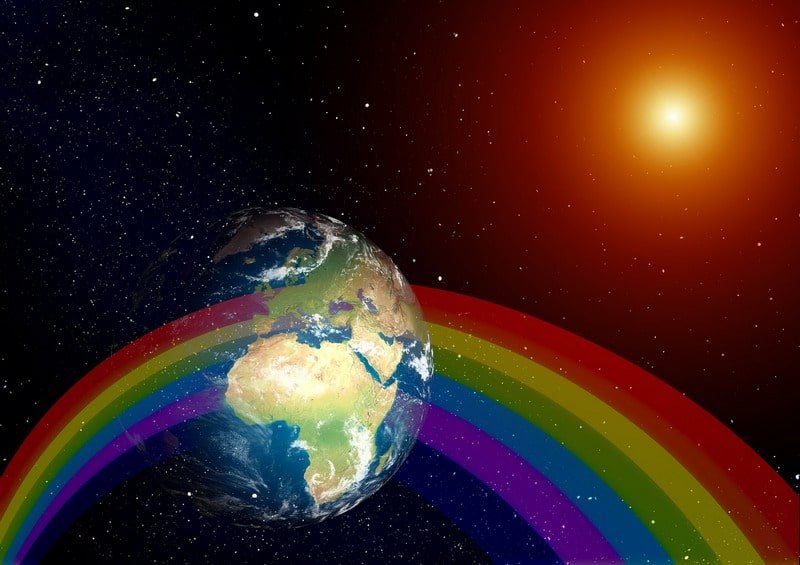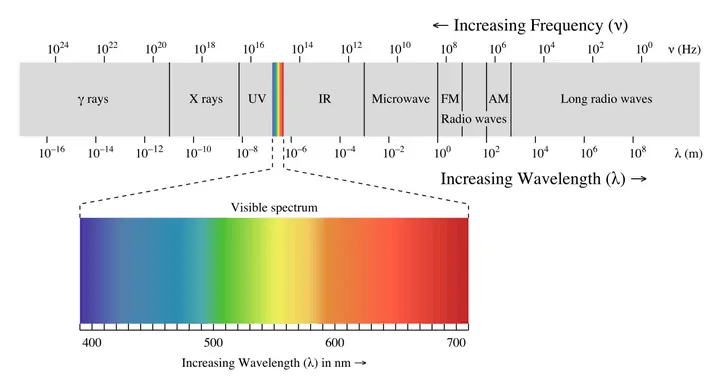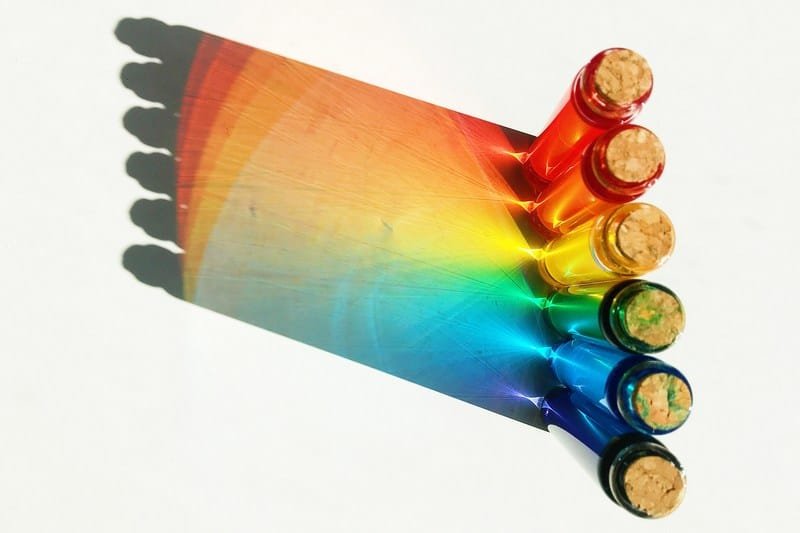What Color Light Do Plants Grow Best in
 The short answer is:
The short answer is:
Blue light.
But it's not quite that simple.
For one, plants grow great in natural sunlight. Sunlight isn't blue. It is…yellow? White?
Wait, what color is sunlight, exactly?
That's a bit of a trick question.
Sunlight contains all colors of the light spectrum. Technically, that makes it white light.
This means it contains blue light. Among all other colors.
It also contains red and yellow and green. Plants like to have those colors as well.
Especially red.
To make it more complicated, the addition of red to blue light makes plants grow far better. Blue on its own works. Red on its own doesn't do much. Red with blue is ideal.
How much of each?
It depends on the plant and the current stage of its growth.
That's getting ahead of ourselves.
Let's first look at why blue and red are most important and what role the other colors play, if any.
Plant Growth Under Different Colors Of Light

As mentioned, plants grow best under a mix of red and blue light. The ideal ratio is somewhere around 5:1 red to blue.
But it does vary, depending on the plant and the stage of growth.
And remember: red light without the blue light is actually worse than blue light without any red light.
Confused?
Let's look at the different colors of the visible light spectrum, plus the two colors just on either side of the visible spectrum, and see exactly how they impact the growth and development of plants.

Ultra-Violet
UV light is harmful to plants, just like it is to humans. That said, in being harmful, it can actually bring about positive side effects.
For example, when cannabis plants are exposed to UV light, they create resin to protect themselves from the harmful rays. This makes the buds more potent.
Violet
On its own, violet light has a limited effect on plant growth, but it is very useful when combined with red and blue light. The addition of violet light enhances the color, taste and smell of plants.
Blue
Blue is the most important light for plant growth, because it is readily absorbed by chlorophyll and converted into energy through photosynthesis.
That said, blue light on its own is not nearly as effective as blue combined with red. And you want far more red than blue light.
Green
Plants appear green, because chlorophyll does not absorb much green light, like it does other colors, and instead reflects it back at us. Based on this, it is easy to assume that plants do not make use of green light for photosynthesis.
Most websites do exactly this.
The truth is, most simply rewrite something they read elsewhere, without actually knowing anything about, or doing any real research on, the topic themselves.
But it isn't quite true.
Plants have other photoreceptors that are responsible for photosynthesis, besides chlorophyll. And those other photoreceptors do absorb green light. If your plants get no green light at all, they would not be able to reach their full potential.
Even more importantly, green light penetrates deeper into the plants than other colors, so it reaches photoreceptors that other colors can't.
Plants may not need nearly as much green light as they do red and blue, but they do need to have some. The action spectrum for photosynthesis proves this. Make sure you provide it for them.
Yellow
Plants make the least use of yellow light, but they do use it as well. Give them some, but they won't need much.
Orange
Orange light is used like red light. It is not the ideal wavelength that a darker red is, but it is still absorbed like red. You want to provide some orange light, but more light that is a darker red than orange.
Red
Red is the second most important wavelength of light for plants. On its own, red is actually not all that effective, but when combined with blue, it becomes incredibly important.
In fact, you want far more red than you do blue, especially during the flowering stages of growth. Adding red light leads to stronger growth with more leaves during vegging and far better fruit and bloom production during flowering. Not only do you get higher yields, but also higher quality yields.
Far Red (Infrared)
Far red light is not absorbed much, but it plays an important role in plant growth and development. The ratio of red to deep red signals to the plant when it should start germination and also regulates flowering time.
Under What Color Light Do Plants Grow Best?

Plants grow best when they have all colors of light. They want mostly red and blue (with about 5 times as much red as blue), with a good amount of light in every other color as well.
So what does that mean when it comes to grow lights?
What Color LED For Grow Light?
Many manufacturers of LED grow lights still subscribe to the outdated notion that plants need only red and blue light. As a result, they make "purple" lights with only red and blue diodes.
Stay away from those lights.
Instead, these two types of lights do the best job:
- lights with mostly red and blue diodes, but also a decent amount of all-white diodes mixed in
- full-spectrum white LED grow lights (like COBs or quantum boards)
There are plenty of good options when it comes to the first, but far fewer for the second.
The best lights that feature red, blue and white diodes are the Advanced Platinum LED lights. They are more expensive than many other brands' though.
A good budget alternative is the King LED line of lights.
For all white lights, check out the Canagrow CREE CXB3590 COB Series.
To be honest, I prefer a light that does not only have all-white COBs, but supplements them with red, blue, UV and IR diodes. That gives you an even better spectrum than pure white light and makes for an absolute flowering monster.
The Phlizon COB Series are the best lights at combining CREE COBs with additional diodes. These lights are basically equivalent to the much more expensive Optic LED lights, but cost half as much.
Is HID Light A Good Color For Plant Growth?
Traditionally, HID light meant either high-pressure sodium (HPS) or metal-halide (MH) light. The former contains a lot of red light, but virtually no blue, while the latter contains a lot of blue light, but virtually no red.
As a result, best results are achieved when both types of bulbs are combined to give plants all the colors they need. But that results in a lot of bulbs, which really drives up energy costs and heat. It also means you need a lot of reflectors and ballasts.
Using MH bulbs for vegging and HPS bulbs for flowering is the most common solution, but it is not ideal. Even though plants want more blue during vegging, they still benefit greatly from also having red light. And the reverse is true during flowering. They need tons of red, but still want some blue.
It is for this reason (among others, like operating cost and simplicity), that I much prefer LED and generally recommend LED grow lights over HID, since they don't even really cost more these days.
That said, if you prefer HID, there is now a great option.
It is a newer type of HID light that combines the two spectra: it has a lot of red like HPS, but also a lot of blue like MH.
This type of bulb is called ceramic metal halide (CMH). If you want to go with HID light, CMH light is by far the best option.
See which fixtures are best here.
Do Fluorescent Bulbs Have Good Light For Plant Growth?
Fluorescent lights give off white light. They generally tend toward cooler light (i.e. light with more blue in it), but warmer bulbs (with a higher red content) are available.
Learn which fluorescent bulbs are best here.
How Well Would A Plant Grow Under Pure Yellow Light?
I get this question a lot. The quick answer is: not well at all.
The reason I get this question is that people see sunlight as "yellow." It is not.
Sunlight is, in fact, white light, that is made up of every single color. It contains yellow light and this is the wavelength that is most visible to us, which is why it appears yellow.
Light similar to sunlight can work great to grow plants, but purely yellow light will not. Ideally, you actually want light with less yellow light than sunlight, since much of it is simply not used by plants.
With sunlight, that does not matter since it is a free energy source. But if you are paying to create the light (as you do with a grow light), what is the point in paying for so much yellow light, if it is not even going to be used?
Best Light Spectrum For Clones?
The best light spectrum for clones is actually the same as the best spectrum for any other stage. You've probably read that clones want blue light, but that is only partially true.
They do need a lot of blue light, but they also need the other colors. The ideal spectrum for plants includes a lot of blue light already, so there is no need for a special spectrum for cloning. Just use what plants already like naturally.
The only thing to pay attention to is the strength of the light. For cloning, you need far less power than for vegging, and especially for flowering. If you use the same light throughout all stages, make sure to dim it when cloning or raise it higher, to ensure the delicate clones are not burned.
If you want to by a light specifically for cloning, get one that covers a much smaller area than you need and hang it higher, to increase the coverage area. This reduces the intensity of the light and makes it safe for your clones.
For example, if you are cloning a 4×4 area, get a light that flowers 2×2 to 2.5×2.5 and hang it higher to increase its coverage to 4×4.
What Color Light Do Plants Grow Best in
Source: https://growlightinfo.com/what-color-light-do-plants-grow-best-in/